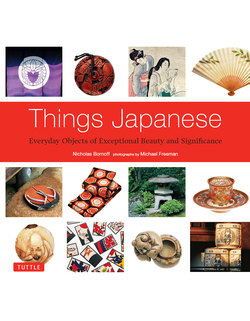Читать книгу Things Japanese - Nicholas Bornoff - Страница 8
На сайте Литреса книга снята с продажи.
ОглавлениеForeword
Outside Japan, the words 'things Japanese' often conjure concepts which the Japanese themselves would greet, at best, with indulgent smiles. Netsuke, inrō, iron kettles, swords and so on—all items that began to go out of fashion when Japan started to open its doors to the outside world following the Meiji restoration of 1868. You could add things like tea ceremony ceramics, paintings on sliding screen doors, tatami mats, stone lanterns and kimono to the list—even though these are alive and well. Some Japanese construe these attributes as grossly antiquated stereotypes, and are likely to resent it when foreigners acclaim them. "Kimono! Geisha! Fuji-yama", they fume, despite the fact that they all not only still exist, but are also exalted by many Japanese (who still wear kimono on special occasions) themselves. They may scoff at 'Fuji-yama' (the Japanese have never called their most famous mountain anything but 'Fuji-san') but, oh, how often one sees travel posters of Mt Fuji with girls in kimono—often holding paper umbrellas for good measure—deployed in the corridors of train stations!
The cutting edge of high technology is undeniably more the stuff of modern Japan than the samurai sword, but several venerable swordsmiths designated 'Living National Treasures' still forge the world's finest blades, just as they did centuries ago. Although obviously diminished, the proliferation of traditional arts and crafts in modern Japan is astonishing. With the introduction of the three-piece suit in the 1870s, inrō (the little tiered medicine boxes hanging from the kimono belt) may have gone the way of netsuke (the amazing miniature sculptures used to toggle them) but the skills of the craftsmen making them remain very much alive, albeit for different applications. Workshops in Kanazawa and Kyoto still make exquisite painted, embroidered or tie-dyed silk textiles; craftsmen all over Honshu and Kyushu continue to produce outstanding ceramics. Japanese lacquerware finds few rivals worldwide; many modern Japanese, whether serious calligraphers or just for writing seasonal greetings, keep a lacquer writing box complete with brushes and ink-stone. Notwithstanding the ferro-concrete urban sprawl, the wooden Japanese house still exists—in many cases just as an interior in a high rise apartment. Some people continue to paint traditional screen doors and, during the summer months especially, everyone likes to sprawl on the cool, comfortable smoothness of the tatami floor.
Many of those old Japanese objects have not lost their relevance, and continue to define the country producing them. People living outside Japan or those interested in its culture travel thousands of miles to the country not to see cars, computers and home entertainment equipment, but to visit the Japan that still uses those 'things Japanese'. Among the Japanese themselves, plenty would happily agree that many such objects remain signifiers of their culture, even if they have never seen them.
To foreigners, these things are the faint embers of a cultural love affair that started burning in the 19th century. It was fired first from woodblock prints, brought to the notice of Europe by France's Goncourt brothers and the impressionist painters. Then it burned all the more fiercely among those travelling to the hitherto hermit nation shortly after its doors first creaked open to the outside world. Believing that such exquisite items could only come from some kind of Fairyland, many of those early lovers of things Japanese were perhaps blinded and naive. However warped their perceptions, the 'things Japanese' they so loved remain, and often flourish. Today, often sought by antique collectors, some are just the stuff of fond memorabilia, but many remain topical and are in everyday use.
